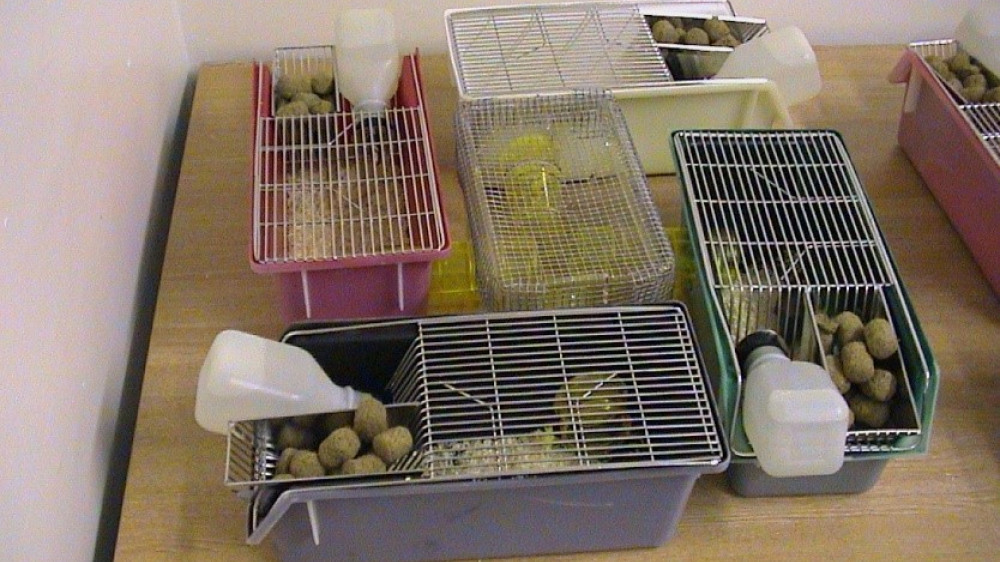Evaluating enrichment approach 1: Monitoring behaviour using an ethogram
Guidance on using ethograms to evaluate environmental enrichment, including examples.
On this page
Choosing which behaviours to monitor
When evaluating environmental enrichment through behavioural observation, the first step is to consider which behaviours you are likely to see and whether these behaviours would generally be considered healthy or abnormal. Your study can then identify which forms of enrichment would minimise the risk or incidence of abnormal behaviours, while maximising the occurrences and range of normal, desirable behaviours.
If you are introducing an enrichment item, such as a new kind of shelter or nest box, you could monitor whether how much the animals use it. For example, you could do this by recording how often the animals go inside the nest box, gnaw on it, climb on top, etc.
If you are introducing short-term/periodic enrichment, such as timed access to playpens or bouts of rat tickling, you could record and compare the behaviour of the animals in their home cage before and after the enrichment session, to show how access to the enrichment affects their behaviour and welfare in the longer term (i.e. outside of the session). The amount of activity, exploratory behaviour, and social interactions the animals perform can be monitored, for example.

‘Positive’ and ‘negative’ behaviours
Animal behaviour is relatively easy to observe and monitor, but it is more difficult to interpret and define which behaviours are desirable in a captive situation. The goal with laboratory animal management should be to protect animals from distressing experiences (as far as possible) while allowing them to carry out ‘positive’, healthy, species-typical behaviours such as exercise, foraging, nesting and social interactions, including play.
‘Negative’ behaviours include distinctly abnormal behaviours, such as stereotypies. These repetitive, unvarying and apparently functionless behaviours usually indicate that the animal is struggling to cope with an inappropriate environment. Examples of stereotypies include pacing behaviour in monkeys and bar mouthing in mice and rats. Negative behaviours can also include natural behaviours performed with abnormal frequency, such as overgrooming/barbering.
Aggression is a natural behaviour in many laboratory animal species, but it is usually desirable to minimise it in a captive situation, to reduce the risk of injury or the need to separate or singly house animals. Some enrichment items have been found to increase aggression, especially if they are in short supply and the animals must compete to gain access to them, so it is important to monitor aggression during enrichment studies for group housed animals.
What is an ethogram?
An ethogram is a list of species-specific behaviours, categorised into a table format. When planning to observe animal behaviour, an ethogram is constructed in advance and used to record behaviour in a systematic way.
Rather than providing details on the different types of ethograms, this resource focuses on information relevant for performing simple behavioural observations relating to environmental enrichment in a laboratory setting. More extensive information on ethograms can be found on the Mouse Ethogram website.
Constructing an ethogram for evaluating enrichment
Constructing an ethogram requires the observer(s) to think about what behaviours they expect to see, which of these they are interested in, and how these behaviours should be defined. We provide some example general ethograms further down this page for laboratory rodents and zebrafish that can provide inspiration, but your final ethogram will be specific to the aims of your study.
You should start by considering the purpose of your study and what you are interested in observing. It is likely you will want to assess whether the enrichment item is used and how the animals use it. You may also be interested in whether certain enrichment reduces the occurrence of stereotypies or increases aggressive interactions. Focus on the behaviours that relate to these aims and consider what you would expect to see.
Once you have an idea of which behaviours you will focus on, you then need to define these. Clearly defining behaviours prior to making observations is essential for consistency in recording behaviour, especially when working as a team. It is also essential that the behaviours do not overlap (i.e. they are entirely separate categories).
The example ethogram below can be used to observe if and how animals use an enrichment item, in addition to whether undesirable behaviours are occurring. Including a ‘code’ column, with abbreviations for each behaviour, allows the behaviours to be quickly noted down on the data collection sheet. Everyone involved in the data collection should be involved in defining the behaviours. Discuss your definitions as a group, for example: Is everyone clear what tail rattling looks like? How is playful chasing differentiated from aggressive chasing? What constitutes mounting?
|
Category |
Behaviour |
Code |
Definition |
|---|---|---|---|
|
Enrichment |
Climbing on |
EC |
Climbing up the sides, using the sides for support while rearing or stretching, moving around on top of, standing still on top of. |
|
|
Resting in/on |
ER |
Lying down with eyes closed while in/on or in contact with enrichment. |
|
|
Gnawing |
EG |
Using teeth to make contact with, biting, chewing or mouthing enrichment. |
|
|
Social |
ES |
Gentle allogrooming, playing or huddling with one or more companion while in/on/touching the enrichment. |
|
|
Aggressive |
EA |
While in or in contact with the enrichment for any part of the interaction: performing or being on the receiving end of aggressive behaviours, such as: chasing, biting, fighting, tail rattling, mounting, aggressive grooming (vigorous pulling of fur, focused on head and shoulders). Note how enrichment was used. |
|
|
Elimination |
EE |
Defecating or urinating in or on the enrichment. |
|
|
Enrich. Other |
EO |
Any other behaviours performed in or in contact with the enrichment that are not defined above (specify in notes) |
|
Non‑enrichment |
Resting |
NR |
Lying down with eyes closed while not in contact with enrichment. |
|
|
Social |
NS |
Gentle allogrooming, playing or huddling with one or more companion while not in contact with enrichment. |
|
|
Aggressive |
NA |
As EA but outside of and not in contact with the enrichment. |
|
Stereotypy |
Stereotypy |
SY |
Repetitive behaviour without clear goal, e.g. bar mouthing, circling, looping. |
|
Immobile |
Immobile |
IM |
Awake (eyes open) but still when standing or lying down. |
|
Other |
Non enrich. Other |
NO |
Any behaviours that do not fall into any of the above categories (e.g. eating). |
Using the ethogram
Everyone who is involved in data collection should have at least one ‘dry run’ to trial the ethogram before your study begins. Have a go at following the data collection steps of your chosen protocol to ensure the ethogram is fit-for-purpose. If it is not, then have a discussion with your colleagues and make the necessary amendments.
Ensure that everyone is recording behaviour in the same way. For example, if a mouse climbs on the enrichment and then defecates on it, should this be recorded as EC or EE? Do the behavioural definitions need editing for clarity?
When you are conducting the study, be objective and stick to the behavioural definitions. It is very important to be consistent.
You will use the ethogram to fill in the appropriate data collection sheet for the protocol you have chosen. There are instructions on how to do this within the example protocols (see below).
For any protocol, additional notes should be made where necessary. In the case of the example ethogram above, it would be important to add additional information when recording aggressive interactions around the enrichment item (EA). It would be useful to know if the animal you are observing (i.e. the focal animal) was the dominant individual and how the enrichment was involved; for example, did the subordinate flee to shelter inside the enrichment, or did the aggressor chase them away from the item? Keeping good records will be invaluable when you come to interpret your data and share your findings.
Example ethograms
We have created printable ethograms that can be tailored to suit your own needs.
- Shelter for mice (Protocol A)
- Playroom for rats (Protocol B)
- General ethograms for zebrafish (page 6 of general ethograms document)
- General ethograms for laboratory rodents (page 1 of general ethograms document)
- General ethograms for laboratory rats (page 4 of general ethograms document)
- General ethograms for laboratory rabbits
More ethograms can be found on the following websites:
Time budgets
Recording the amount of time animals spend performing different behaviours allows you to observe their ‘time budget’. Time budgets are created by first defining an ethogram, recording the amount of time spent on each activity and expressing this as a fraction or percentage of the total observation time (or animal’s day or active period). Looking at time budgets gives extra insight into counts of behaviours. For example, an animal may have performed a single incident of aggression and a couple of incidents of play. However, looking at the duration spent performing these behaviours may reveal that the one single incident of aggression took up 90% of the observation time (i.e. there was more negative behaviour occurring than positive despite the number of incidents being the same). More information on creating a time budget is available from the Mouse Ethogram website.
Pros and cons
The advantages of the ethogram approach are:
- You can compare behaviour before and after the enrichment is introduced.
- You can record a wide variety of behaviours.
- Insight can be gained into possible welfare concerns (e.g. excessive time spent grooming in the absence of the enrichment item, or increased aggression in the presence of the enrichment item).
- Insight can be gained into possible refinements (e.g. fewer biting incidents occurring when non-aversive handling is adopted, or reduced incidents of overgrooming when allowed access to a playpen).
- Little additional equipment is required, and observations can be conducted in the standard home cage.
- Behaviour can be video recorded and observed/coded later at a convenient time.
Care should be taken with this approach because:
- Behaviours need to be clearly defined for consistency. For example, how would you describe ‘resting’ or ‘playing' to a colleague so that they could record data in line with your own? Does resting include sleeping or are these separate behaviours? ‘Awake but inactive’ has recently been defined as an indicator of poor welfare; is everyone clear what this would look like?
- It is up to the observer to interpret the behaviours in the context of welfare. For example, higher activity levels in the presence of enrichment could indicate an increase in confident, exploratory behaviour or a more agitated, stressed state.
Further information on methods for recording animal behaviour is given in a one-hour video tutorial on the NC3Rs Macaque Website (see Recording behaviour) and these videos from Wild Discoveries.
Guidance on using preference tests to evaluate environmental enrichment. (Image credit: C. Sherwin.)

